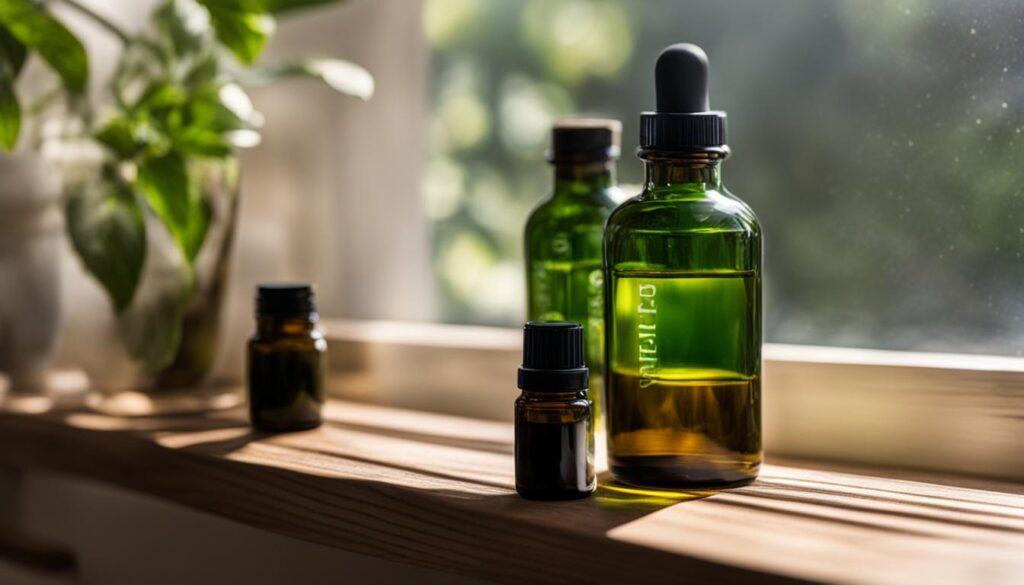Peppermint oil is a versatile essential oil that offers a wide range of uses and benefits for health and wellness. Derived from the leaves of the peppermint plant, Mentha x piperita, this natural remedy has been used for centuries for its therapeutic properties.
One of the key components of peppermint oil is menthol, which gives it a distinct cooling sensation and refreshing aroma. This makes peppermint oil a popular choice for various applications, including culinary, personal care, household, and topical uses.
When it comes to health benefits, peppermint oil has been found to relieve digestive issues such as indigestion, bloating, and gas. It can also help alleviate headaches and promote healthy skin and hair. With its soothing and invigorating properties, peppermint oil is a valuable addition to any natural remedy toolkit.
Key Takeaways:
- Peppermint oil offers a wide range of uses and benefits for health and wellness.
- It can relieve digestive issues, soothe headaches, and enhance skin and hair health.
- Peppermint oil is used in culinary, personal care, household, and topical applications.
- Its main components are menthol and menthone, derived from the leaves of the peppermint plant.
- When using peppermint oil, it is important to follow usage tips and precautions.
The History and Origins of Peppermint Oil

Peppermint oil has a rich history that dates back centuries, where it was widely recognized and valued for its medicinal properties. The origins of peppermint oil can be traced to the ancient civilizations of Egypt, Greece, and Rome, where it was prized for its aromatic and therapeutic qualities.
During the time of Ancient Egypt, peppermint oil was used in various remedies, particularly for digestive ailments and respiratory conditions. The Egyptians believed in its powerful healing abilities and often incorporated it into their religious ceremonies.
In Ancient Greece, the renowned physician Dioscorides documented the medicinal uses of peppermint oil in his famous work, “De Materia Medica”. Its use expanded beyond digestion to include applications for headaches, pain relief, and as a general tonic.
Rome, known for adopting and refining Greek medical knowledge, also embraced peppermint oil. The Roman naturalist Pliny the Elder praised peppermint for its cooling and invigorating properties, using it to treat indigestion and even to stimulate the mind.
Peppermint oil derives from the peppermint plant, scientifically known as Mentha x piperita. This hybrid plant is a cross between watermint (Mentha aquatica) and spearmint (Mentha spicata). It naturally thrives in regions of North America and Europe, where it has been cultivated for centuries.
Origins of the Peppermint Plant
The peppermint plant, Mentha x piperita, is believed to have originated in the Middle East and Mediterranean regions. As its popularity grew, it spread to other parts of the world, including North America and Europe, where it found favorable climates and growing conditions.
Today, peppermint is widely cultivated in regions such as the United States, particularly in the Pacific Northwest, and in Europe, particularly in countries like England and France. These regions offer the ideal combination of cool temperatures, abundant rainfall, and rich soil, creating the optimal environment for peppermint growth.
“Peppermint oil has a long and storied history, with its roots in ancient civilizations. From Egypt and Greece to Rome, peppermint oil has been treasured for its therapeutic properties, making it a timeless remedy.”
| Country of Origin | Main Cultivation Regions |
|---|---|
| United States | Pacific Northwest |
| Europe | England, France, and other countries |
In conclusion, the history of peppermint oil is rooted in the ancient civilizations of Egypt, Greece, and Rome. It has been revered for centuries for its therapeutic properties and has found a natural home in regions like North America and Europe. The rich heritage and widespread cultivation of peppermint make it a valuable and time-tested natural remedy.
Properties and Key Components of Peppermint Oil
Peppermint oil is renowned for its diverse properties and key components that contribute to its beneficial effects. The main constituents of peppermint oil are menthol and menthone, which give it its characteristic cooling and refreshing odor and taste.
However, peppermint oil also contains a multitude of other compounds that enhance its properties and benefits. These include menthyl acetate, cineole, limonene, pulegone, and carvacrol, among others. Together, these components create a powerful synergy that makes peppermint oil a valuable resource for various applications.
One of the notable properties of peppermint oil is its ability to relax smooth muscles, making it particularly effective at relieving digestive issues such as indigestion, bloating, and abdominal cramps. By acting as an antispasmodic agent, peppermint oil can provide soothing relief to the gastrointestinal tract.
In addition, peppermint oil exhibits anti-inflammatory effects, potentially reducing inflammation in the body and alleviating associated discomfort. This property may contribute to its efficacy in mitigating symptoms of conditions like irritable bowel syndrome (IBS) and functional dyspepsia.
Moreover, peppermint oil has been found to affect the natural bacteria present in the gastrointestinal tract. It may help rebalance the gut microbiota, supporting healthy digestion and overall gut health.
To summarize, the properties of peppermint oil are diverse and encompass its ability to relax smooth muscles, possess anti-inflammatory effects, and impact the natural gut bacteria. These properties, combined with the key components of menthol and menthone, make peppermint oil a versatile and valuable essential oil for promoting digestive wellness and overall health.
Culinary and Personal Products Uses of Peppermint Oil

Peppermint oil is a versatile essential oil that has found its way into the culinary and personal care industries. Its refreshing scent and cooling properties make it a popular choice for various applications.
Culinary Uses of Peppermint Oil
Peppermint oil is widely used as a flavoring agent in a variety of culinary creations. Its cool and refreshing taste adds a delightful twist to both sweet and savory dishes. Here are some popular culinary uses of peppermint oil:
- In desserts: Peppermint oil is often added to cookies, cakes, and chocolates, giving them a refreshing minty flavor.
- In beverages: From refreshing iced teas to festive holiday drinks, a few drops of peppermint oil can elevate the flavor profile.
- In savory dishes: Peppermint oil can be incorporated into sauces, dressings, and marinades, adding a unique twist to savory dishes like lamb or pork.
With its strong and concentrated flavor, it’s important to use peppermint oil sparingly in culinary applications. A little goes a long way!
Personal Products Uses of Peppermint Oil
Peppermint oil’s refreshing and antibacterial properties make it a popular ingredient in various personal care products. Its invigorating aroma and potential skin benefits make it a versatile addition to your daily self-care routine. Here are some personal products uses of peppermint oil:
- Oral care: Peppermint oil is commonly found in toothpaste, mouthwashes, and dental floss due to its refreshing scent and antibacterial properties.
- Soaps and body washes: Peppermint oil is added to soaps and body washes for its pleasing scent and potential skin-soothing effects.
- Shampoos and conditioners: Some hair care products contain peppermint oil to promote a healthy scalp and potentially improve hair growth.
When using personal care products containing peppermint oil, it’s essential to follow the manufacturer’s instructions and recommendations for proper usage.
Household and Topical Uses of Peppermint Oil

Peppermint oil is not only beneficial for health and wellness, but it also offers various household and topical uses. Its antimicrobial properties make it an excellent natural insect repellent. By using peppermint oil, you can keep flies, ants, spiders, and other pests at bay. Simply dilute a few drops of peppermint oil with water and spray it around doorways, windows, and areas where these pests are commonly found.
Another household use of peppermint oil is in cleaning solutions. Due to its refreshing scent and disinfectant properties, it can be added to homemade cleaning sprays and solutions. Peppermint oil not only helps to kill bacteria and germs but also leaves a pleasant fragrance behind. This makes it a great choice for maintaining a clean and fresh environment in your home.
When it comes to topical uses, peppermint oil has a wide range of applications. It can be used to relieve itching caused by insect bites or skin irritations. Simply apply a small amount of diluted peppermint oil to the affected area for quick relief. Peppermint oil also has a cooling effect on the skin, which makes it ideal for soothing muscle pain and tension. You can mix a few drops of peppermint oil with a carrier oil like coconut oil and massage it onto sore muscles for relief.
Additionally, peppermint oil is known to help alleviate headaches and migraines. Its refreshing aroma and menthol content can provide a calming sensation and help reduce pain. Apply a diluted mixture of peppermint oil to your temples or the back of your neck and gently massage it in to experience its soothing effects.
Peppermint oil is commonly found in topical preparations, such as creams and ointments, due to its potential benefits for the skin and its pleasing aroma. It is often included as an ingredient in products designed to soothe and nourish the skin, providing a refreshing and invigorating experience.
Household and Topical Uses of Peppermint Oil
| Household Uses | Topical Uses |
|---|---|
| Natural insect repellent | Relieves itching |
| Cleaning solutions | Soothes muscle pain |
| – | Alleviates headaches |
Benefits and Applications of Peppermint Oil

Peppermint oil offers a wide range of benefits for both physical and mental well-being. Its versatile properties and soothing effects make it a popular choice for various applications.
Gastrointestinal Relief
Peppermint oil is highly regarded for its ability to alleviate symptoms of gastrointestinal conditions. It can effectively relieve abdominal pain, bloating, and digestive issues associated with irritable bowel syndrome (IBS). Other gastrointestinal conditions, such as functional dyspepsia and abdominal pain in children, can also be eased with the use of peppermint oil.
Nausea Reduction
For individuals experiencing postoperative nausea or motion sickness, peppermint oil can offer relief. Its natural compounds can help reduce nausea and provide a calming effect on the stomach, making it a valuable remedy in such situations.
Pain Relief
Peppermint oil has pain-relieving properties that can help alleviate common discomforts. It is beneficial for headaches, muscle aches, and joint pain. By applying peppermint oil topically, individuals can experience soothing effects and a reduction in pain.
Skin and Hair Care
The soothing effects of peppermint oil extend to the skin and hair. It can help alleviate itching and provide a refreshing sensation, making it an excellent addition to skincare products. Additionally, peppermint oil may have the potential to promote hair growth, adding volume and vitality to locks.
| Benefits of Peppermint Oil | Applications of Peppermint Oil |
|---|---|
| Gastrointestinal relief | Alleviates symptoms of IBS, functional dyspepsia, and abdominal pain in children |
| Nausea reduction | Helps reduce postoperative nausea and motion sickness |
| Pain relief | Relieves headaches, muscle aches, and joint pain |
| Skin and hair care | Alleviates itching and potentially promotes hair growth |
Usage Tips and Cautions for Peppermint Oil

When it comes to using peppermint oil, it’s essential to follow some important tips and take necessary precautions for a safe and effective experience. Whether you’re using peppermint oil for its various health benefits or incorporating it into your daily routine, here are some guidelines to keep in mind:
- Consult with a healthcare professional: Before using peppermint oil, it’s advisable to consult with a healthcare professional, especially if you have any underlying health conditions or if you’re pregnant or breastfeeding. They can provide personalized guidance based on your specific needs and ensure safe usage.
- Avoid ingesting pure peppermint oil: Peppermint oil should not be ingested in its pure form as it is highly concentrated and can be irritating to the digestive system. Instead, it’s best to use peppermint oil topically or in diluted forms.
- Perform a patch test: Before applying peppermint oil to a larger area of your skin, it’s important to perform a patch test. Apply a small amount of diluted peppermint oil to a small area of your skin and wait for at least 24 hours to check for any adverse reactions or irritation.
- Proper storage: To maintain the quality and potency of peppermint oil, it should be stored in a cool, dark place. Direct sunlight and heat can degrade the oil and reduce its effectiveness. Keeping the bottle tightly sealed will prevent air and moisture from affecting its quality.
By following these usage tips and exercising caution, you can safely incorporate peppermint oil into your routine and enjoy its numerous benefits.
| Usage Tips for Peppermint Oil | Cautions for Peppermint Oil |
|---|---|
| – Dilute peppermint oil before topical use | – Avoid ingesting pure peppermint oil |
| – Perform a patch test before applying to a larger area | – Consult with a healthcare professional, especially during pregnancy or if you have underlying health conditions |
| – Store peppermint oil in a cool, dark place to maintain quality | – Peppermint oil may cause skin irritation in some individuals |
| – Keep peppermint oil out of reach of children and pets, as it can be toxic |
Selecting the Best Quality Peppermint Oil

When it comes to choosing peppermint oil, it’s crucial to prioritize quality. Opting for a high-quality product ensures that you’ll reap the maximum benefits and achieve the desired results. To select the best peppermint oil, here are some essential factors to consider:
- Botanical Name and Country of Origin: Look for peppermint oil that clearly states the botanical name as Mentha x piperita and specifies the country of origin. This information confirms the authenticity and purity of the oil.
- Reputable Brands: Choose peppermint oil from trusted and reputable brands that adhere to industry best practices. These brands are more likely to prioritize quality in their manufacturing processes and sourcing of ingredients.
- Dark-Colored Glass Bottles: The packaging of peppermint oil is essential for maintaining its potency. Dark-colored glass bottles provide protection against light exposure, which can degrade the oil over time.
- Customer Reviews and Recommendations: Reading customer reviews and seeking recommendations from reliable sources can provide valuable insights into the quality and effectiveness of different peppermint oil brands.
By paying attention to these factors, you can confidently select the best quality peppermint oil that suits your needs and ensures optimal results.
Note: The image above represents the best quality peppermint oil, showcasing the vibrant green color and fresh peppermint leaves, evoking a sense of purity and natural goodness.
Proper Storage of Peppermint Oil

To ensure the longevity and quality of peppermint oil, proper storage is essential. The storage conditions play a crucial role in maintaining the aroma, freshness, and therapeutic properties of the oil. Here are some tips for storing peppermint oil:
- Store in a cool place: Peppermint oil should be kept in a cool environment, away from direct sunlight and heat sources. Exposure to heat can cause the oil to degrade and lose its effectiveness.
- Avoid light exposure: Light can also degrade the quality of peppermint oil. It is recommended to store the oil in a dark place, such as a cabinet or a drawer.
- Keep the bottle tightly sealed: Air and moisture can affect the potency of peppermint oil. Ensure that the bottle is tightly sealed after each use to prevent any air or moisture from entering.
By following these storage guidelines, you can maintain the quality and effectiveness of peppermint oil for an extended period.
| Storage Tips for Peppermint Oil |
|---|
| Store in a cool place, away from heat sources and direct sunlight |
| Avoid light exposure by keeping the oil in a dark place |
| Ensure the bottle is tightly sealed to prevent air and moisture from entering |
Proper storage of peppermint oil is essential to maintain its quality and potency. By storing it in a cool, dark place and keeping the bottle tightly sealed, you can enjoy the benefits of peppermint oil for a longer period.
Potential Side Effects and Precautions of Peppermint Oil
While peppermint oil is generally safe for most people, it is important to be aware of potential side effects and take certain precautions when using it. Some individuals may experience side effects such as heartburn, nausea, and skin reactions when using peppermint oil. It is advised to perform a patch test on a small area of skin before applying peppermint oil to a larger area to check for any adverse reactions.
It is also crucial to note that peppermint oil may interact with certain medications. If you are currently taking any medications, it is recommended to consult with a healthcare professional before incorporating peppermint oil into your routine. They can provide guidance on its safe usage and potential interactions with your medications.
Caution should be exercised when using peppermint oil around children and pets. Peppermint oil can be toxic to them, and ingestion or direct application should be avoided. It is essential to keep peppermint oil out of reach and stored securely.
Pregnant and breastfeeding individuals should avoid using peppermint oil due to limited safety information. It is always best to consult with a healthcare professional before using any essential oils during pregnancy or while breastfeeding.
Summary of Potential Side Effects and Precautions:
- Some individuals may experience side effects such as heartburn, nausea, and skin reactions when using peppermint oil.
- Perform a patch test on a small area of skin before applying peppermint oil to a larger area.
- Consult with a healthcare professional before using peppermint oil if you are taking any medications.
- Avoid using peppermint oil around children and pets, as it can be toxic to them.
- Pregnant and breastfeeding individuals should avoid using peppermint oil due to limited safety information.
| Side Effects | Precautions |
|---|---|
| Heartburn | Perform a patch test on a small area of skin before applying peppermint oil to a larger area. |
| Nausea | Consult with a healthcare professional before using peppermint oil if you are taking any medications. |
| Skin reactions | Avoid using peppermint oil around children and pets, as it can be toxic to them. |
Conclusion
Peppermint oil is a versatile and beneficial essential oil that offers a wide range of uses and benefits for health and wellness. Its unique properties make it an effective natural remedy for various conditions and concerns.
One of the key uses of peppermint oil is its ability to alleviate digestive issues, such as bloating, indigestion, and nausea. It can help relax the muscles in the gastrointestinal tract and promote healthy digestion. Additionally, peppermint oil has been found to have pain-relieving properties, making it effective for relieving headaches, muscle aches, and joint pain.
Furthermore, peppermint oil may have beneficial effects on the skin and hair. It can help soothe irritation, itchiness, and redness, making it a valuable ingredient in skincare products. Peppermint oil has also been suggested to potentially promote hair growth and prevent hair loss.
While peppermint oil offers numerous benefits, it’s important to use it with caution. Always follow recommended guidelines and consult with a healthcare professional if you have any underlying health conditions or are taking medications. By understanding the uses, benefits, and potential side effects of peppermint oil, individuals can make informed decisions about incorporating it into their daily lives.
FAQ
What are the uses and benefits of peppermint oil?
Peppermint oil has a wide range of uses and benefits, including relieving digestive issues, headaches, and muscle pain. It can also enhance skin and hair health and be used in aromatherapy.
Where does peppermint oil come from?
Peppermint oil is derived from the leaves of the peppermint plant, Mentha x piperita. It is a hybrid plant that is a cross between spearmint and watermint.
What are the key components of peppermint oil?
The main components of peppermint oil are menthol and menthone, but it also contains other compounds that contribute to its properties and benefits.
How can peppermint oil be used in culinary and personal products?
Peppermint oil can be used as a flavoring agent in foods and beverages, as well as in the production of mouthwashes and other oral care products. It is also added to soaps and cosmetic products for its scent and potential skin benefits.
What are the household and topical uses of peppermint oil?
Peppermint oil can be used as a natural insect repellent and in cleaning solutions to disinfect surfaces. It can also be applied topically to relieve itching, soothe muscle pain, and alleviate headaches.
What are the benefits and applications of peppermint oil?
Peppermint oil can help relieve symptoms of digestive issues, such as irritable bowel syndrome (IBS) and functional dyspepsia. It may also reduce nausea and have pain-relieving properties. Additionally, peppermint oil can have soothing effects on the skin and potentially promote hair growth.
What are some usage tips and cautions for peppermint oil?
It is recommended to consult with a healthcare professional before using peppermint oil, perform a patch test before applying it to a larger area of skin, and store it in a cool, dark place to maintain its quality and potency.
How can I select the best quality peppermint oil?
Look for peppermint oil that clearly states the botanical name (Mentha x piperita) and the country of origin. Choose peppermint oil from reputable brands that follow industry best practices. Dark-colored glass bottles are preferred for packaging.
How should peppermint oil be stored?
Peppermint oil should be stored in a cool, dark place away from direct sunlight and heat sources. The bottle should be tightly sealed to prevent air and moisture from entering.
What are the potential side effects and precautions of peppermint oil?
Peppermint oil can cause side effects in some individuals, such as heartburn, nausea, and skin reactions. It may also interact with certain medications. It should be used with caution around children and pets, and pregnant and breastfeeding individuals should avoid it due to limited safety information.






